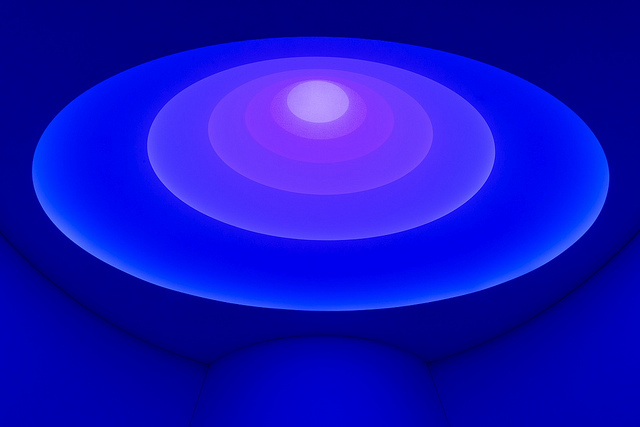
The artist James Turrell has transformed the spiral rotunda of the Guggenheim Museum in New York City into a contemplative environment, an atmospheric display of light and color. Aten Reign is a series of concentric oval scrims that fill the central space of the museum, illuminated by colored light that cycles through the spectrum. It is not a traditional art object but more of a perceptual experience, like a constantly transforming indoor sky.
Rather than depict the effects of light as a painter might do, he uses light as a medium in itself, to be directly experienced. There is something inherently spiritual about this, especially given Turrell’s Quaker background, with its emphasis on the light within each soul.
I went to see Aten Reign on a humid, thunderstorm-filled summer day. The Guggenheim website had warned of diminished visitor capacity, but as soon as I turned the corner beyond the admissions desk, the installation appeared overhead, with a cluster of seated admirers gazing up at it.
I saw six concentric ovals, with the brightest color at the lowest one, fading in intensity as they ascended. The smallest, highest oval remained almost white, no matter how the others changed. I remembered that the Guggenheim’s spiral has a skylight at the summit. The topmost oval seemed to be admitting natural light from this oculus, the unadulterated “outside” sky that contrasted with the more color-enhanced “indoor” sky. The structure suggested ascension to heavenly purity, but there was also a descending energy, like an all-seeing eye was looking down at the aspirants below it. The title of the installation reinforces this interpretation. Aten, the sun disk, was deified in ancient Egypt, a non-anthropomorphic god depicted as triangularly expanding rays of light, a life-giving force from above.
Sometimes the color was intense and artificial, like the glaring magenta of a cineplex lobby, and other times there was barely any color at all, just the elegant curves of the ovals to observe.
Discerning the actual structure of the piece is difficult, and one isn’t meant to know. I’d read that it was constructed like nested scrim lampshades. I could see a faint moiré pattern that must have been produced by the fabric layers. At first this seemed like a visual flaw—a slip was showing—but I soon came to appreciate the effect. I saw it as a veil that still retained the mystery of what was behind it.
In an age of intense commodification, it is refreshing to experience art that is not a precious object, that is not even an object at all, but a perceptual experience. The seeing itself is the art, and the art is created within each viewer. Being aware and attuned as your sense perceptions unfold is a goal and a gift. Turrell has made it easier by stripping away the superfluous and giving us only color and shape to contemplate. It is more than enough.
Aten Reign and other works by James Turrell will be at the Guggenheim Museum through September 29, 2013.




2 Comments
Izzy B.
I went to the show, and your description of it is PERFECT. You conveyed so well not just what it looks like, but also how it makes you feel as a viewer. Very powerful stuff, this art.
James W.
I was entranced by this review, my senses firing on all cylinders thanks to your incredibly evocative descriptions. A genuine treat to read…thank you!